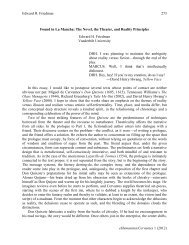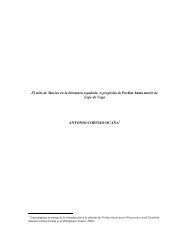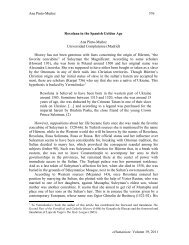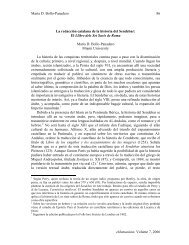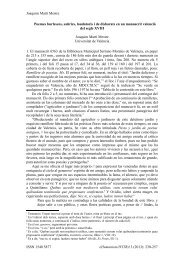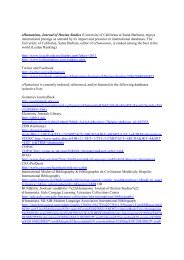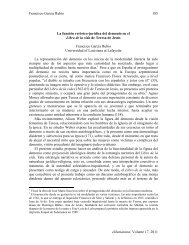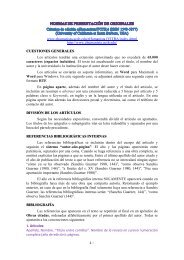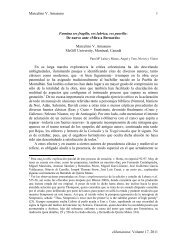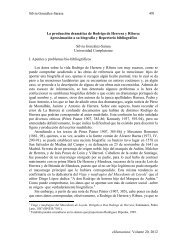Gregory Peter Andrachuk eHumanista: Volume 17, 2011 540 Alonso ...
Gregory Peter Andrachuk eHumanista: Volume 17, 2011 540 Alonso ...
Gregory Peter Andrachuk eHumanista: Volume 17, 2011 540 Alonso ...
Create successful ePaper yourself
Turn your PDF publications into a flip-book with our unique Google optimized e-Paper software.
<strong>Gregory</strong> <strong>Peter</strong> <strong>Andrachuk</strong><br />
Viceroy’s family is his family. This clue, added to the others in the first part of<br />
Qüestión de amor strongly suggests that the authorial voice is the voice of a Cardona. 8<br />
In other words, the author has provided the astute reader 9 with the clues necessary<br />
to determine his identity –although these clues must be examined in the context of the<br />
work as a whole, taking into account both the frivolous atmosphere of the first part<br />
which incorporates some fictitious elements (the most obvious of these being the<br />
debate between Flamiano and Vasquirán) as well as the explicitly historical second<br />
part. In the latter “no ovo más ni ha avido un punto menos de lo que fue y cómo passó.<br />
Assí que los agudos y discretos miren de aquí adelante los nombres verdaderos y<br />
tornen atrás, que allí los hallarán” (158). Indeed, as Françoise Vigier remarks, at this<br />
point in the text “l’auteur anonyme invite ici à une relecture à rebours, dans le but<br />
d’identifier les personnages de la fiction” (325, n.692). Among those “personnages”<br />
we must count Vasquirán. But we have seen that the clues to the identity of Vasquirán,<br />
that is, the author, are embedded on a deeper level than those of the other characters,<br />
and must be deciphered using more sophisticated means, not simply a matching of<br />
first letters of names. The astute reader will be open to other nuances in the text –one<br />
of which we have just seen– Vasquirán’s wearing of the Cardona colours and indeed,<br />
the very clothing of the Viceroy, his kinsman.<br />
The clues in the second part are subtle and serve to confirm rather than establish<br />
the identity of the author as a Cardona. As he begins to describe the preparations for<br />
the battle of Ravenna (11 April, 1512), a battle which effectively decimated the court<br />
of Naples and which put an end to the society described in Qüestión de amor, the<br />
author mentions as presages of the coming disaster the deaths of two important<br />
persons within three weeks of one another: those of the Condesa de Avellino (on<br />
October 24, 1511) and Luis de Borja (on October 5, 1511). We have already noted the<br />
close relationship of the latter with both Vasquirán and with the Viceroy. The former<br />
was Juana de Villamarín, wife of Juan de Cardona, Conde de Avellino and Viceroy of<br />
Calabria (whose identity is lightly masked in the first part of the work as the “Conde<br />
de Avertino”).<br />
Her husband Juan de Cardona and Juan’s brother Antonio de Cardona, Marqués de<br />
la Pádula, are listed among the capitanes de gente de armas in the description of the<br />
preparations for the battle at Ravenna (166). One might argue that the presence of<br />
these Cardonas is historically undeniable and that therefore their mention here is<br />
8 A fuller analysis of the clues is found in <strong>Andrachuk</strong> 2006 (xvii-xxxii). The author has made a similar<br />
use of colour symbolism to identify Flamiano. Jerónimo de Fenollet, accepted as the real identity of the<br />
character Flamiano, appears in the list of nobles preparing for the encounter at Ravenna wearing the<br />
same colours and divisa used earlier by Flamiano. See Vigier 345, n.780 and <strong>Andrachuk</strong> 2006, <strong>17</strong>0,<br />
n.369. I intend to show later in this paper that the author is indeed related to Ramón de Cardona.<br />
9 The author’s comments in the Argumento y declaración de toda la obra on the ludic aspect of his<br />
work differentiate between those who will read at a superficial level, and by implication, those who will<br />
read more deeply. When he speaks of the former as those “que leyeren sin leer” he is making reference<br />
to both the primary and secondary meanings of leer, the latter being “comprehender y penetrar el<br />
interior” (Diccionario de Autoridades IV, 377).<br />
544<br />
<strong>eHumanista</strong>: <strong>Volume</strong> <strong>17</strong>, <strong>2011</strong>



